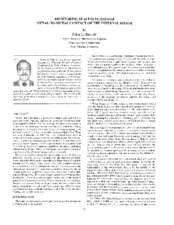| dc.contributor.other | International Pump Users Symposium (11th : 1994) | |
| dc.creator | LeBleu, Julien | |
| dc.date.accessioned | 2017-10-05T17:08:49Z | |
| dc.date.available | 2017-10-05T17:08:49Z | |
| dc.date.issued | 1994 | |
| dc.identifier.uri | https://hdl.handle.net/1969.1/164210 | |
| dc.description | Lecture | en |
| dc.description | pg. 41 | en |
| dc.description.abstract | Monitoring vibration as a predictive maintenance tool will not consistently prevent catastrophic damage and/or fluid release from sealess pumps. When vibration readings are taken periodically, a pump may be destroyed between monitoring schedules. Using acceleration to monitor the internal rotor of a sealess pump does not work as well as it does on a sealed pump configuration. There are several reasons for this. First, the internal rotor mass is relatively low when compared to the rest of the pump. The external mass dampens the vibration signal and a clear interpretation is not always possible. Second, vibration generated by inconsistent fluid flow during abnormal operating conditions can create confusing vibration amplitudes. Thirds, sealess pumps are relatively new and experience with vibration interpretation is limited. Monitoring sealess pumps by means other than vibration are generally reactionary, such as indicating the presence of liquid where none should be or detecting the conditions that will result in internal rotor damage. Also, some devices that monitor internal rotor condition create an additional leak path from the pump to atmosphere. Internal rotor monitoring methods generally rely on “wearing through something” to create a signal that is detectable outside of the pump. The signal is representative of the remaining bearing life. These methods are not effective unless the internal pump wear is uniform over time. This uniformity is often lacking, because the process fluid cools and lubricates the inside of the pump and periods to reach wear limits often vary. All of the wear could have taken place in the last hour, even if the pump has been running for the last 12 months. | en |
| dc.format.medium | Electronic | en |
| dc.format.mimetype | application/pdf | |
| dc.language.iso | en | |
| dc.publisher | Turbomachinery Laboratories, Department of Mechanical Engineering, Texas A&M University | |
| dc.relation.ispartof | Proceedings of the 11th International Pump Users Symposium | en |
| dc.subject.lcsh | Pumping machinery | en |
| dc.title | Monitoring Sealless Pumps For Metal-To-Metal Contact Of The Internal Rotor | en |
| dc.type.genre | Presentation | en |
| dc.type.material | Text | en |
| dc.identifier.doi | https://doi.org/10.21423/R1XX1B | |


